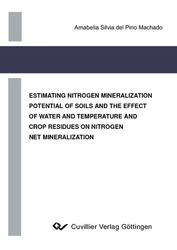| Areas | |
|---|---|
| Serie de libros (96) |
1378
|
| Nachhaltigkeit |
3
|
| Gesundheitswesen |
1
|
| Letra |
2363
|
| Ciencias Naturales |
5406
|
| Matemática | 229 |
| Informática | 319 |
| Física | 980 |
| Química | 1363 |
| Geociencias | 131 |
| Medicina humana | 243 |
| Estomatología | 10 |
| Veterinaria | 108 |
| Farmacia | 147 |
| Biología | 835 |
| Bioquímica, biología molecular, tecnología genética | 121 |
| Biofísica | 25 |
| Nutrición | 45 |
| Agricultura | 1004 |
| Silvicultura | 201 |
| Horticultura | 20 |
| Ecología y conservación de la tierra | 148 |
| Ciencias Ingeniería |
1791
|
| General |
98
|
|
Leitlinien Unfallchirurgie
5. Auflage bestellen |
|
Erweiterte Suche
Estimating Nitrogen Mineralization Potential of Soils and the Effect of Water and Temperature and Crop Residues on Nitrogen Net Mineralization (Tienda española)
Amabelia Silvia del Pino Machado (Autor)Previo
Indice, Datei (80 KB)
Lectura de prueba, Datei (100 KB)
Chemical and physical procedures were tested to forecast soil net N mineralization in a group of eight soils of Lower Saxony, varying in pedological characteristics as well as management. Most of the indexes tested were well related to N mineralization obtained through incubation under controlled conditions, being less related to the N uptake by crops, probably because this parameter was limited by differences among crops. Factors affecting N mineralization were studied in soils of Uruguay through incubation, assessing simultaneously soil microbial activity through CO2 evolution. To evaluate the influence of the amount and quality of plant residues the effect of wheat straw (WS) and N addition was tested. The WS rate determined the extent of N immobilization, which was very fast. Mineral N availability influenced the remineralization of immobilized N, being higher in N depleted soils. There was a negative effect of fertilizer N addition on soil biomass, partially counteracted by WS amendment. This effect could be caused by the pH decrease and increased salt concentration of the soil solution. The next study compared decomposition patterns of different plant materials, crop residues and green manures. Chemical composition of plant materials influenced the pace of the decomposition process. No single chemical component could explain differences in decomposition patterns. The soluble C content was responsible for the initial decomposition flush, later cellulose and hemicellulose determined in a greater extent the decomposition pace. The phenolic compounds were negative along the whole incubation. Plant materials with low N concentrations at low N levels did not show differences in decomposition patterns, despite differences in composition. Although N concentration of residues did not affect decomposition pace, was the most important characteristic explaining net N mineralization. The influence of temperature on soil organic matter (SOM) mineralization followed an exponential model in the range from 5 to 40ºC. The calculated Q10 values, for both N and C mineralization, indicate a slightly more than two fold mineralization rate increase per each 10ºC increase in the two studied soils, despite differences in texture and SOM. There was a direct relationship between C and N mineralization and gravimetric soil water content, although the two studied soils showed differences in the response to changes in water content. Substantial microbial activity was observed at high water tensions, indicating that in dry periods mineral N is likely to accumulate in the soil.
| ISBN-10 (Impresion) | 386537509X |
| ISBN-13 (Impresion) | 9783865375094 |
| ISBN-13 (E-Book) | 9783736915091 |
| Formato | A5 |
| Idioma | Alemán |
| Numero de paginas | 188 |
| Edicion | 1 Aufl. |
| Volumen | 0 |
| Lugar de publicacion | Göttingen |
| Lugar de la disertacion | Göttingen |
| Fecha de publicacion | 15.02.2005 |
| Clasificacion simple | Tesis doctoral |
| Area |
Geociencias
|








